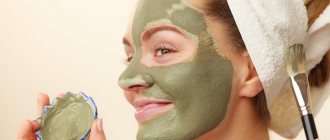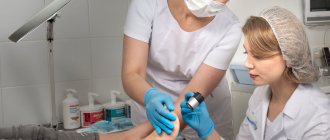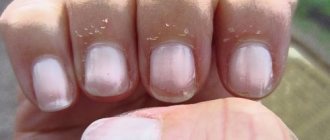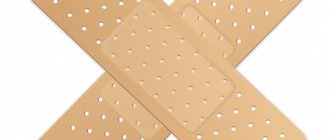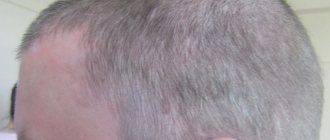Causes of warts on the feet
The human papillomavirus, or HPV, causes plantar warts to grow. Scientists know over 100 types of this virus.
It has different effects on a person. Most types are harmless—in the worst-case scenario, they cause warts to grow.
But there are also dangerous types of HPV. In rare cases, they provoke the development of genital cancer.
The causes of warts on the feet are HPV types 1, 2, 4, 27 and 57. The virus enters through the skin. Usually through small cuts, scratches and other damage.
Under the influence of the virus, skin cells mutate and turn into tumors.
This doesn't happen in one day. The incubation period of HPV can last up to six months, and even then it affects the skin in different ways. Depends on immunity. For some family members, warts will grow quickly after infection, while for others they will never appear.
Fortunately, plantar tumors are not very contagious, but at the same time they remain a threat even without direct contact. The virus survives in warm and humid environments. That is, on the floor next to the pool or in the common locker rooms. So doctors recommend wearing slippers or other shoes in these rooms.
Plantar warts grow especially often in people:
- Childhood and adolescence
- With a weak immune system
- Re-infected with HPV
They also appear due to:
- Wearing tight and uncomfortable shoes
- Using someone else's socks or tights
- Heavy sweating on the feet
External signs of infection are not always the same - several varieties are known.
How to cure plantar warts
When a plantar wart appears, the question arises of how to cure this tumor. When the growths cause excessive discomfort and spread quickly, the best solution is to contact a dermatologist as soon as possible, he will select the most appropriate treatment option. There are several ways to solve this problem.
The most radical of them is surgical: the wart and its roots are surgically removed. This method is not the most effective, since the roots of the tumor are located in the deep layers of the skin. In some cases, it is not possible to completely remove them.
Wart removal can be done using laser and electrocoagulation, as well as cryotherapy.
In addition to removal in medical institutions, plantar warts can be removed using less radical methods, such as ointments, solutions, special patches, as well as folk remedies. These products for removing plantar warts have a number of advantages and disadvantages, the main one of which is the long treatment time.
Removal of plantar warts
One of the most common ways to remove plantar warts is to remove them in specialized medical institutions. At the appointment, the dermatologist should tell you in detail how to get rid of plantar warts and, based on the results of the examination, choose the most suitable method. Despite the fact that thorns are difficult to cure, there is no specific means of removing them; all methods that are appropriate for the treatment of other types of warts are used. Removal of plantar warts can occur on an outpatient basis, but your doctor can prescribe remedies to help remove the growths at home.
Surgical removal of warts
Along with other treatment methods, surgery is used to remove warts. The wart is scraped out with a special scalpel under local anesthesia. After this procedure, if the plantar wart is large, sutures are placed under the skin and removed within one to two weeks. The wound site is treated with a disinfectant solution and an aseptic bandage is applied. There is usually a small scar left at the site of removal.
The complexity of this method is that during the operation the doctor must remove all the roots, otherwise the plantar wart will appear again. Therefore, this method is used today only if all other treatment methods have been ineffective.
Liquid nitrogen removal
Removal with liquid nitrogen involves exposing the neoplasm to extremely low temperatures; this is the most common modern and fastest way to treat plantar warts.
The method is based on freezing the tumor tissue itself. In fact, inside the wart cells, under the influence of an extremely low temperature of -196 degrees Celsius, ruptures occur, leading to the death of the wart.
Cryodestruction is carried out manually or using hardware. If the wart is large or the procedure is performed on a child, then it becomes necessary to use local anesthesia, usually novocaine.
The exposure time to direct liquid nitrogen is up to 30 seconds. After the first cauterization, the doctor should pause to assess the effectiveness of the effect and the need for repeated cauterization.
After freezing, a bubble with a colorless or reddish liquid forms at the site of the wart, which indicates the beginning of the inflammatory process. This is a normal reaction to the cauterization procedure.
Cryodestruction is considered painless, but when treating plantar warts it must be repeated several times to achieve the final effect. After the wart falls off, there are no scars left.
The advantages of liquid nitrogen removal are:
- freezing prevents further spread of the disease to the nearest skin;
- lack of special training;
- short duration of the procedure;
- the risks of developing scars or cicatrices are minimal.
The disadvantages of cryodestruction of plantar warts are:
- the need to repeat the course if the affected area is large or due to the size of the wart;
- the human factor - the professionalism of the doctor performing this procedure is a guarantee of success. The doctor must correctly assess the time and degree of exposure of the tissue to nitrogen, otherwise a burn may form;
- the discomfort that a swollen bladder brings and the need to treat it are also considered disadvantages of the method.
In general, reviews of the treatment of plantar warts using liquid nitrogen cauterization are positive, since this is the simplest, most effective and affordable method.
Laser removal
Laser removal is considered one of the most effective and safe methods. After laser treatment, the wart ceases to be infectious. The procedure itself is painless; the laser has a special attachment built into it that cools the treatment site. Additionally, one or more pain-relieving injections are given before the operation. The patient usually feels a slight tingling sensation during the procedure. After removing the tumor, there are no traces left, since the laser directly burns the diseased tissue. The laser method allows maximum control over the depth of exposure, which is individual in each case. Therefore, even with deep tissue damage, it is possible to completely remove the roots, which means preventing the regrowth of the wart.
The operation takes place under sterile conditions, there is no direct contact with the skin or wart, and the operation lasts only a few minutes. Positive results when removing plantar warts using a laser also make this method the most attractive.
The main disadvantage of laser plantar wart removal remains the high cost, which usually includes a doctor’s consultation, anesthesia and the operation itself. In addition, the wound takes a long time to heal after removal and requires compliance with hygiene rules.
Treatment of plantar warts
Before treating a plantar wart, you need to make sure the diagnosis is accurate and then proceed directly to the procedures. In addition to surgical interventions, the doctor may prescribe immunotherapy and topical medications.
The need for immunotherapy is usually justified, since the disease is caused by a virus, which actively develops when the body is weakened. Topical immunotherapies directly target the virus in two ways. In the first case, the drug stimulates the immune system, and in the second, an antigen is introduced into the body of the wart, which also activates the immune system, so that the wart can disappear faster.
Treatment of a plantar wart takes quite a long time; it is important not to forget to strengthen the immune system and maintain hygiene. If removal and treatment are not applied, the wart can go away on its own for more than a year, while the person is a source of infection for everyone around him. You should pay close attention to this unpleasant disease and be sure to consult a dermatologist, who will definitely tell you how and how to treat a plantar wart.
Treatment of a plantar wart directly depends on compliance with all hygiene standards and doctor’s instructions; daily treatment of the formation is a guarantee of successful recovery.
Treatment at home
Any new formations on the skin cannot be ignored, since cancer awareness is now growing all over the world. You should not ignore an appointment with a specialist; he can prescribe treatment for plantar warts at home. In this case, special solutions, ointments, and a patch for warts are usually prescribed.
Ointments are one of the mildest methods of treatment; they act on the wart itself, as a result of which it gradually dies and disappears. The following types of ointments are used in treatment:
- antiviral ointment;
- acid-based ointment;
- various ointments based on herbal remedies.
The most commonly prescribed ointments are salicylic acid and oxolinic ointment. Any type of ointment is applied pointwise to the wart several times a day in accordance with the instructions. When treating a plantar wart, before applying the drug, it must be steamed in warm water in advance. It is advisable to apply any ointment at night so that you do not have to step on the formation and wash off the ointment.
To get rid of plantar warts at home, you can use a special salicylic acid-based patch. This product has low cost and proven effectiveness. The patch is sold in pharmacies without a prescription, the principle of its use is very simple - a wart is sealed with a piece of the patch, and a regular medical plaster is attached on top. The patch needs to be changed at certain intervals. It may take about two weeks to remove a small wart, and you should not leave the wart without a patch for a long time. As treatment progresses, the area of the wart decreases; after 12 hours it becomes covered with a crust, which then disappears. After successful treatment, a small pinkish spot remains on the skin, which should completely disappear over time.
When applying the patch, you must be careful - when applying it, you should avoid healthy areas of the skin, otherwise severe irritation may occur. There are contraindications for using this method of wart removal, so the decision to prescribe a patch must be made by a doctor.
Another way to treat plantar warts at home is hyperthermia. The feet affected by warts are immersed in the hottest possible water. Such procedures are repeated several times. In some cases, hyperthermia shows a positive effect. The mechanism of the procedure is based on the stimulation of small blood vessels in the legs and activation of local immunity.
At home, you can use low temperature treatment, similar to removing warts with liquid nitrogen. To do this, you can use special applicator pens or sprays. As with cryoablation, multiple applications may be required.
Treatment with folk remedies
Despite the fact that modern medicines are much more effective and with their help the process of removing plantar warts occurs faster, the effectiveness of treatment with folk remedies cannot be denied. Traditional medicine has accumulated vast experience in combating warts, and some methods remain effective.
- Celandine juice is one of the most popular methods for removing spines. You can use the juice of a fresh plant or purchase Mountain Celandine at the pharmacy, which contains, in addition to celandine juice, other herbal extracts. The juice is applied once or twice a day to the affected area.
- Acetic acid, along with various additional agents, is also used to remove warts. In addition to acid, onions and flour are used. You can directly drip the acid itself onto the affected area, but this method is quite dangerous due to the high risk of severe burns.
- Apple cider vinegar: a swab soaked in the solution (it is important not to use undiluted vinegar) is applied to the affected area of the skin; the area of skin is first treated with an abrasive nail file.
- Garlic is another folk remedy for treating warts. Raw garlic should be rubbed on the formation until it completely disappears, but this method can be used for no more than three weeks.
- A banana peel is applied with the inside to the affected area of the skin; it is believed that it can pull out the wart.
In order to precisely treat the affected area and not affect adjacent tissues, you can use a piece of adhesive tape. A hole is made in it according to the size of the tumor, and the adjacent healthy skin remains untouched. This avoids burns and other injuries.
Plantar wart in a child
With age, a person develops immunity to HPV, so children and young people are more susceptible to this infection. Most often, the disease affects children aged five years and older. A doctor will help you recognize a plantar wart in a child, since in some cases it may resemble an old callus.
Although plantar warts in a child go away on their own, you should not ignore their treatment; you should also remember about the possibility of infecting the entire family and people around you. A plantar wart in a child almost always causes severe painful discomfort when walking, and therefore requires prompt treatment and consultation with a doctor. Our service features verified pediatric dermatologists and reviews
about them, according to which you can choose a good specialist for your child.
Since children are sensitive to pain, choosing a therapy is quite difficult. To begin with, it is worth using various ointments - they are accessible, easy to use and effective. Folk remedies are also widely used, the safety of which can be assured.
Effective methods for removing plantar warts in children are liquid nitrogen and laser removal. Removing warts using these methods is considered to be the most radical methods. They are resorted to when solutions and ointments do not have the desired effect.
After treatment, it is important not to forget about the prevention of plantar warts in children. These include strengthening the immune system, practicing good hygiene and wearing the right comfortable shoes. It should be remembered that the risk of infection is especially high in public places and from another person, so you need to make sure that the child does not walk in someone else’s shoes or barefoot. Any item that has come into direct contact with the formation must be thoroughly washed at high temperature. All of these actions will help prevent the virus from developing in the future.
What do warts on the foot look like?
Not all growths on the soles are identical. Therefore, sometimes patients confuse warts with other growths and this interferes with effective treatment.
Fortunately, the signs of viral foot warts are easy to remember:
- Small, hard lumps, usually at the base of the toes or on the heel
- Dark spots on the skin are superficial vessels overflowing with blood
- Rough, hardened skin around a noticeable spot that causes the wart to grow deeper into the leg
These formations are also characterized by other symptoms. For example, they cause pain and irritation when walking, which often causes changes in gait. This is how the body fights the unpleasant sensations of warts. Sometimes patients themselves do not notice these changes.
It is recommended to remove such growths.
Propolis and cornflower seeds
- Small painful formations can be treated with propolis. You need to measure out a pea-sized piece of raw material, chew it and attach it to the papilloma. Cover with adhesive tape and do not remove the application for several days. Clean the skin with pumice, wash and apply a new portion of propolis. After 4-5 procedures, the growth disappears.
- Traditional medicine suggests removing tumors with cornflower seeds. A large spoonful of seeds should be crushed into powder, the affected area should be sprinkled with medicine, covered with gauze and bandaged. The product should be applied to steamed skin and not removed for 12 hours. The course of therapy is 2-3 weeks.
- Good results can be achieved by mixing cornflower seed powder with the same amount of butter or melted lard. The resulting ointment should be used for compresses on warts once a day before bedtime.
Why you need to get rid of warts
Up to 90% of neoplasms on the soles do not affect health and life. A few growths just appeared. And after a couple of months they disappeared. Sometimes people do not have time to visit a doctor, but the warts already disappear, without medications or therapy. And no problems with unpleasant sensations.
Unfortunately, not everyone is so lucky.
The remaining 10% of growths can make life extremely difficult - sometimes they cause severe pain when walking and limit mobility.
How to get rid of warts on the foot?
The first step is to be examined by a dermatologist. The doctor makes the diagnosis easily.
Treatment is prescribed if the formation:
- Constantly growing
- Causes the appearance of other neoplasms
- Hurts badly
- Makes it difficult to walk normally
Typically, patients like to treat warts with medications and avoid surgery.
Ask your dermatologist about topical treatments for plantar growths. There are many such drugs. They gradually destroy tumor cells. But they don't give a 100% guarantee.
Drug methods act on warts very slowly and sometimes take months to remove the growths. What’s even worse is that the tumors may return.
Yes, this does not always happen, but such cases are not uncommon. Therefore, to effectively treat viral warts on the foot, we recommend using one of the surgical methods.
There are many treatment options.
Causes and symptoms of the disease
Papillomavirus is a common infection transmitted through household contact. It can easily become infected in the absence of careful hygiene, as well as in swimming pools, saunas and other public places with high humidity.
The infection enters the body through the slightest damage and lies dormant for a long time. The active phase is provoked by unfavorable factors:
- decreased immunity,
- hypothermia,
- lack of vitamins,
- chronic diseases,
- flat feet,
- prolonged stress,
- frequent colds.
At the initial stage, a wart on the leg rarely causes discomfort. Sometimes the growth disappears on its own if a person is closely involved in improving immunity. But this rarely happens. Usually the neoplasm is injured, covered with keratinized layers of skin and hurts during physical activity.
To find out exactly the nature of the growths on the foot, you should go to the hospital and undergo an examination. The specialist will scrape off the upper stratum corneum and send it for analysis. Treatment is prescribed based on the clinical picture of the patient.
Many people are in no hurry to see a doctor, preferring to deal with defects on their own. It is easier to get rid of plantar warts at home when they first appear. Old papillomas have a deeper root and are more difficult to remove without professional intervention.
How to eliminate warts on the foot and prevent their occurrence
Let's start with an attack on neoplasms.
Doctors remove warts on the foot with the following operations:
- Laser coagulation
The doctor burns out the altered skin cells with a powerful beam of light and at the same time bakes the neighboring vessels. The procedure is bloodless and painless. Sometimes it is impossible to remove all the growth in one session and you need to visit the doctor several times to completely clean the skin. Then the wound on the skin heals for at least a couple of weeks.
- Cryodestruction
The dermatologist freezes the wart tissue with liquid nitrogen. The growth freezes completely. Gradually the tissues die, and only the wound remains - after two weeks this too goes away. This method has few complications. However, the procedure is prohibited for women during pregnancy and for people with diabetes.
- Surgical excision
The doctor uses local anesthesia and cuts out the wart with a scalpel. Along with the wart, it also removes a small layer of healthy skin - this ensures complete elimination of the tumor. A wound remains. It is stitched, and after treatment there is always a scar. Due to cosmetic disadvantages, this method is not very popular.
- Immunotherapy
The doctor prescribes drugs to strengthen the immune system - they help the body fight the virus and the growths on the skin disappear. Sometimes doctors give injections into the wart. Or they treat it with a special cream.
- Electrocoagulation
The operation is similar to excision, but is performed not with a scalpel, but with the help of a special device that generates high-frequency electric current. In fact, the growth is burned off with electricity. A wound remains. It becomes crusty and heals in only a few weeks.
Remember - warts appear due to the human papillomavirus and therefore they will continue to multiply until HPV is defeated.
Pay more attention to prevention.
To reduce the risk of infection:
- Avoid touching warts or be sure to wash your hands after touching them.
- Do not walk barefoot near swimming pools or in locker rooms
- Inspect and wash the soles of your feet every day
- Do not scratch the growths
- Do not use the same pumice stone for healthy skin and warts.
- Treat scratches and other damage promptly
- Lead a healthy lifestyle
- Wear comfortable, loose shoes
These simple tips will help protect your body from frequent HPV infections. Occasionally, the virus will still sneak in, but in such situations you need to rely on your immunity. As you remember, in most cases growths do not appear. And if they grow, they do not cause discomfort. It is extremely difficult to find a healthy person who regularly suffers from painful and uncomfortable growths on the feet.
Unfortunately, sometimes you cannot do without treatment.
Therefore, it is useful to read about the nearest clinics and find out the cost of plantar wart removal.
Using Vinegar
It is allowed to treat warts on the soles of the feet with table and apple cider vinegar. It burns out tumors from the inside and quickly cleanses the skin.
- You need to mix half a teaspoon of vinegar with a pinch of flour and shape the dough into a flat cake. Cover the wart with a plaster, leaving a small hole for growth. Cover the papilloma with dough and bandage it. Remove after 12 hours. Usually, after several procedures, the skin defect disappears.
- Small warts can be cauterized with vinegar twice a day for 2 weeks. It is better to apply applications to large formations. Feet should be washed with soap, dried and lubricated with Vaseline. Soak a cotton swab in vinegar and cover the growth. Fix with a plaster for 6-12 hours, then remove and clean the skin with water. During treatment, a burning sensation may be felt, which is normal. If the discomfort is very severe, it is better to remove the bandage before the specified time to prevent burns.
- Fresh onions will help cleanse the skin of new growths. You need to cut the peeled vegetable into slices, add apple cider vinegar and leave overnight. In the morning, take out 1 plate, place it on the plantar wart and secure it with a band-aid. Apply the bandage 2 times a day for 2-3 hours.
Types of warts
In shape, growths in children can be round, thread-like, oval or asymmetrical. Doctors distinguish several types of warts, which differ in color, size, and structure:
- Vulgar:
most often formed on the hands and can be either single or in the form of merging clusters. They look like small, towering growths with a rough surface and clear contours. - Palmoplantar:
Large growths on the soles or palms that resemble calluses. Usually they are single and grow deeply into the tissue, forming painful growths with a rigid structure. - Juvenile:
can occur on any part of the body. Their distinctive features are their uneven shape, smooth surface and rapid keratinization. - Pointed:
grow on the mucous membranes and look like rounded formations, similar to cauliflower.
Diagnostics
Before starting treatment for warts, the doctor performs an external examination of the child and determines the type of tumor. In some cases, the patient may be referred for a biopsy (if there is a suspicion of oncology) or for a PCR test (a method that detects the DNA of the HPV pathogen in a person’s blood). To clarify the diagnosis, dermatoscopy is performed.
Wart removal methods
Treatment of warts includes a set of measures aimed at suppressing the activity of the virus and safely removing growths. Viral warts are often accompanied by increased sweating. In such situations, additional therapy is prescribed to get rid of excessive sweating.
To remove warts in children, the safest and most painless methods are chosen:
- cryodestruction – helps remove growths by freezing them with liquid nitrogen;
- chemical destruction - performed by treating formations with alkali or acid (used only for children over 12 years old);
- electrocoagulation – exposure to electric current;
- radio wave method using the Surgitron apparatus - eliminates warts due to the action of radio waves;
- micropulse laser PinPointe FootLaser – eliminates skin formations using a laser beam.
Laser removal of warts in children
At the Podology Clinic, warts are removed from children using the unique and only laser device in Moscow, PinPointe FootLaser.
A micropulse laser cuts and seals the capillaries that feed the wart, it stops growing and after some time dries up and falls off. Laser therapy is an absolutely painless and effective method for removing skin tumors! Several sessions will allow you to get rid of small elements forever without burns or relapses; large ones will require at least 3-4 visits to the doctor. Our center employs qualified dermatologists who will painlessly remove any type of formation. An individual approach, the use of modern laser equipment, innovative treatment methods that are painless and safe – these are the advantages of the clinic that will effectively solve any dermatological problem in a child.
Causes of warts
The main cause of warts in children is the papilloma virus.
Children and adolescents become infected with this pathogen through contact through household items, personal hygiene items, clothing and underwear. Infection occurs in public places, in transport, on playgrounds. It is possible to transmit microorganisms from mother to child during pregnancy. Once on the skin, the virus enters the body through microcracks and wounds. The disease may not manifest itself in any way for a long time. The activation of microorganisms and the appearance of growths occurs under the influence of a number of factors:
- weakened immunity;
- hormonal changes during adolescence;
- unbalanced diet;
- avitaminosis;
- sedentary lifestyle;
- lack of personal hygiene;
- stress, chronic fatigue;
- wearing uncomfortable shoes (relevant for plantar warts).
Important! Neoplasms appear mainly in weakened children with weak immune systems.
Prevention of warts
Preventive measures are aimed at strengthening the immune system:
- taking vitamin complexes;
- good nutrition;
- physical activity;
- walks in the open air;
- limited stay in public places (if possible).
The answer to the question of how to remove warts from children in the least traumatic and effective way will be answered by the doctors of the SM-Doctor clinic. A dermatologist will quickly and objectively make a diagnosis and prescribe treatment. Remember that removing tumors on your own is dangerous for the child’s health.

